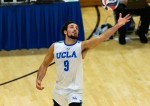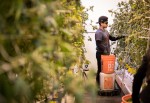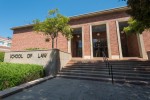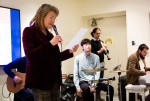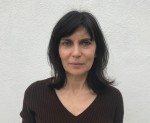The Bruins have let it rip from the service line this season, but it has come with a cost.
No. 6 UCLA men’s volleyball (4-1) has struggled from the service line to begin the 2019 season. Despite posting a number of wins early in the schedule, service errors continue to appear in the box score.
The Bruins have logged 112 service errors through the first five games of the season. Coach John Speraw said after the game against McKendree, the frequency of the errors is something that needs to be worked on.
“It concerns me,” Speraw said. “We’re going to have to think about how we prioritize the time in the practice environment. We’re going to have to take a closer look at some of our fundamentals and really get better at (serves).”
UCLA posted a season-high 30 service errors against unranked UC San Diego, along with 29 against unranked McKendree on its road trip to the Midwest. The Bruins recorded a similar number against McKendree last season with 27.
Speraw said given the strengths of the lineup, serving should be a strength, but inconsistency has limited the Bruins’ ability to challenge opponents.
“The interesting thing is that it should be a great strength of ours as we have a number of guys that can really hit it hard,” Speraw said. “But we’re just not hitting it in the court, and then that’ll affect some of our confidence in letting it rip, so then we’re not putting as much pressure on our opponents as we have the potential to do.”
However, the Bruins have seen this issue before.
Through the same amount of games last season, the Bruins recorded 102 service errors, but had 42 service aces, seven more than the 35 posted so far this season. UCLA finished last season with 653 service errors – averaging more than 19 per match – compared to its opponents’ 483.
Redshirt junior opposite Brandon Rattray said building confidence will continue to improve serving numbers.
“(Serving) comes with confidence,” Rattray said. “It’s something we just have got to keep working on. We just have to keep knowing we’ve got to bring the service heat. We do need to keep working on our serves, as that will be huge for us going forward, getting our serves inbound at a high percentage with good velocity to keep teams out of system.”
The Bruins finished last season with 212 services aces, more than twice as many as their opponents’ 104. Junior middle blocker Daenan Gyimah said UCLA will continue to focus its serving around power.
“We just have embraced our service errors and just kept on ripping from the backline tonight,” Gyimah said. “We’re going to have a lot of errors but they’re not going to have good passes a lot of the time. Those errors will come down as the season progresses, but for now, it’s tough.”
The Bruins will face No. 12 UC Santa Barbara and No. 1 Long Beach State on Wednesday and Saturday, respectively.
